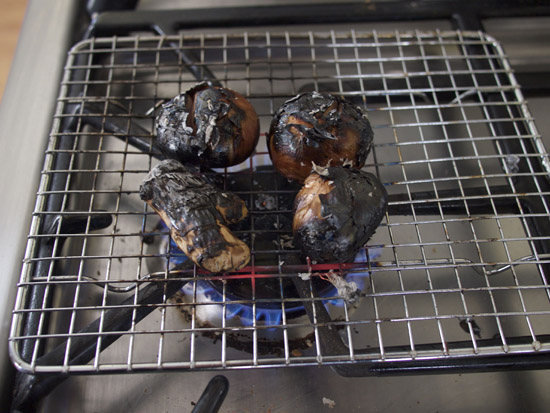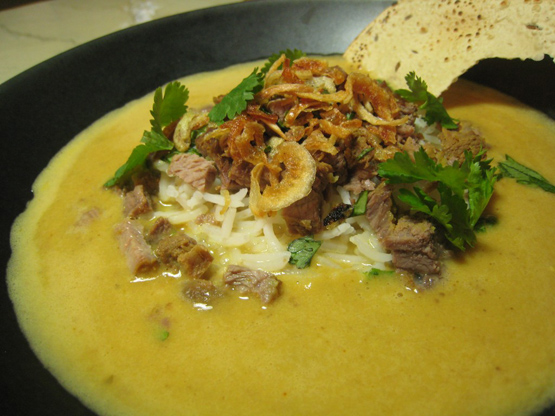Boston’s weather these past couple of weeks has deliciously hinted that warm spring days are imminent. Some days the temperature has risen into the low 70Fs bringing everyone out in t-shirts and shorts playing tennis or going for bike rides. But with overnight temperatures suddenly dropping to the low 40Fs, we’re still also bundling up in our winter coats, scarves and hats. This cyclical weather brought a stomach bug into our house and our 6 year old was the first to succumb. In Vietnam, when he regained his appetite after an illness a bowl of chicken phở was what he craved. But now he only eats vegetarian.
When I was searching for vegetarian recipes in Vietnam I came across a lot of fabulous, slurp worthy noodle soups. The vegetarian versions of phở I tasted were all based on the beef version, with warming spices of star anise, cinnamon and cloves, and not the comforting, restorative, ginger-infused chicken phở my son preferred.

I like to use a small steel cooling rack, specifically for this purpose, of charring ginger and shallots. It’s also handy for eggplant, peppers and tomatoes.
So I set out to prepare a vegetarian broth reminiscent of what he was used to. As I charred the shallots and ginger on the gas stovetop, to mellow and sweeten their flavors, I pulled out some homemade vegetable stock from the freezer and defrosted it. (If you’re going to use a store bought boxed vegetable stock try to use one that is lighter in color and not the orangey-red hue from too much carrots and tomato. Check out The Kitchn’s taste test of vegetable stocks).
Fish sauce is out, so I used some soy sauce and miso to boost the umami factor in the broth. (A small number of vegetarian cooks I met in Vietnam have started to add a touch of miso to their broths for added depth of flavor). The broth and noodles would satisfy my son’s needs but the healthy family members (though we all eventually caught the bug) were going to be eating the phở as our dinner so I needed to consider the rest of the bowl’s contents.
Living back in North America this year I’ve encountered some products in grocery stores that are new to me. I’ve increasingly become curious with the plant based meat alternatives from Beyond Meat. I’ve been impressed by the lightly seasoned Beyond Chicken strips – particularly their flavor, texture and the way they hold up when they are heated. I had a package in the fridge, as I was planning to stir-fry them with lemongrass and chile for dinner one night, so I decided to use them as the chicken garnish. They shred up nicely and require a brief dunk in boiling water to be reheated before being added to the bowl. If you who don’t eat fake meat analogues, or can’t access them because of where you’re living, I’ve given a variation using tofu skin sticks and oyster mushrooms.
The garnishes of bean sprouts, thinly sliced spring onions, and herbs (cilantro, Thai basil and mint) are straightforward but I do love the added rich sweet flavor from fried shallots. If you do attempt to make the fried shallots, and I highly recommend that you do, I suggest you make them first or even the day before. They’re highly addictive – you might have to control yourself from nibbling through them before they reach the soup bowl. If you’re unfamiliar with how to make them and want to give them a go David Tanis has a simple recipe for you to follow. It’s worth frying a ½ pound of sliced shallots (about 5-6 of them) for the 1 cup of oil he suggests. Reserve the fragrant oil to drizzle over salads or even into the phở for an extra fatty mouthfeel.
It’s only been during the last decade that some chicken phở vendors in Hanoi started to add some thinly sliced lime leaf as a garnish. I like how the essential oils in the leaves bring a pleasant citrusy fragrance flavor to the dish. If you buy fresh lime leaves (avoid dried lime leaves as they are flavorless) you’ll have more than you need for this recipe. Store the fresh leaves in a ziploc bag in the freezer, for up to a few months, and pull them out when need for this dish or a favorite Thai dish.
If you’re using the tofu skin sticks soak them either the night before (or before you leave for work) as they take some time to rehydrate (though I’ve also given a ‘quick’ rehydrate method).
Tofu skin sticks are made from the skin that forms on the surface of simmering soymilk. The skin is gently pulled off, crumpled together and hung on a stick or rack to dry. You can buy dried tofu skin sticks at Vietnamese or Chinese grocers. In Vietnam, you’ll find them at stalls at fresh food markets that sell dried pantry items like dried beans, rice paper wrappers and soy or fish sauce.
2 tofu skin sticks
1/4 lb (112 g) oyster mushrooms, torn or cut into bite sized pieces (approximately 2 cups)
To Rehydrate the Tofu Skin Sticks
Long soak method
Eight hours before you plan to eat the soup place the tofu sticks in a casserole dish (snap them, trying to keep them in long lengths, if they’re too long for the dish). Fill the casserole dish with hot tap water. Since the tofu skin sticks will float I’ll use a small mesh rack (you can lay a large stainless steel spoon, or something that won’t float, across them) to keep them immersed. The tofu skin sticks will rehydrate overnight (or put them in the water before leaving for work).
Quick Soak Method
If you’ve forgotten to soak them and need to ‘speed’ up the process, turn your oven on to 200F and add the casserole dish (filled with hot water). (Set the timer on your phone or leave a note near the oven - I sometimes will even tape a piece of paper with the time I should check what's in the oven to the oven door- as a reminder that the tofu skin sticks are in the oven).
I’ve found the constant gentle heat quickens the process of the water penetrating the center of the sticks. They should be ready after about 1 to 1 ½ hours. To fully hydrate the tofu skin sticks they need to be gently hydrated which is why a quick boil, say like boiling pasta, does not work (they lose their shape and become slimy).
The tofu skin sticks are fully hydrated when they have turned a lighter color and when you cut through them there is no dried parts at the core of the stick.
To use them in the soup, cut the sticks into 2-inch (5 cm) lengths and either pull them apart into shreds or cut them 3 or 4 times lengthwise. Discard any parts that are tough (this often tends to be the thin curved part that touched the stick or rack when drying). Place the tofu shreds into a bowl or onto a plate and cover with a damp towel and wrap with plastic wrap so that they don’t dry out.






